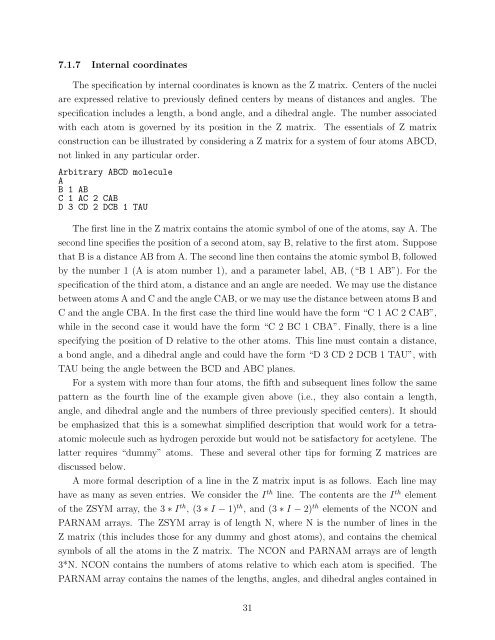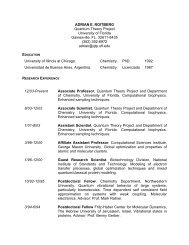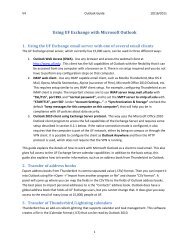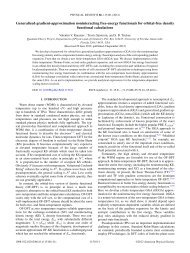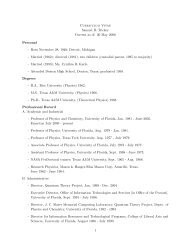ACES II User manual version 2.7.0 (PDF) - Quantum Theory Project
ACES II User manual version 2.7.0 (PDF) - Quantum Theory Project
ACES II User manual version 2.7.0 (PDF) - Quantum Theory Project
You also want an ePaper? Increase the reach of your titles
YUMPU automatically turns print PDFs into web optimized ePapers that Google loves.
7.1.7 Internal coordinatesThe specification by internal coordinates is known as the Z matrix. Centers of the nucleiare expressed relative to previously defined centers by means of distances and angles. Thespecification includes a length, a bond angle, and a dihedral angle. The number associatedwith each atom is governed by its position in the Z matrix.The essentials of Z matrixconstruction can be illustrated by considering a Z matrix for a system of four atoms ABCD,not linked in any particular order.Arbitrary ABCD moleculeAB 1 ABC 1 AC 2 CABD 3 CD 2 DCB 1 TAUThe first line in the Z matrix contains the atomic symbol of one of the atoms, say A. Thesecond line specifies the position of a second atom, say B, relative to the first atom. Supposethat B is a distance AB from A. The second line then contains the atomic symbol B, followedby the number 1 (A is atom number 1), and a parameter label, AB, (“B 1 AB”). For thespecification of the third atom, a distance and an angle are needed. We may use the distancebetween atoms A and C and the angle CAB, or we may use the distance between atoms B andC and the angle CBA. In the first case the third line would have the form “C 1 AC 2 CAB”,while in the second case it would have the form “C 2 BC 1 CBA”. Finally, there is a linespecifying the position of D relative to the other atoms. This line must contain a distance,a bond angle, and a dihedral angle and could have the form “D 3 CD 2 DCB 1 TAU”, withTAU being the angle between the BCD and ABC planes.For a system with more than four atoms, the fifth and subsequent lines follow the samepattern as the fourth line of the example given above (i.e., they also contain a length,angle, and dihedral angle and the numbers of three previously specified centers). It shouldbe emphasized that this is a somewhat simplified description that would work for a tetraatomicmolecule such as hydrogen peroxide but would not be satisfactory for acetylene. Thelatter requires “dummy” atoms. These and several other tips for forming Z matrices arediscussed below.A more formal description of a line in the Z matrix input is as follows. Each line mayhave as many as seven entries. We consider the I th line. The contents are the I th elementof the ZSYM array, the 3 ∗ I th , (3 ∗ I − 1) th , and (3 ∗ I − 2) th elements of the NCON andPARNAM arrays. The ZSYM array is of length N, where N is the number of lines in theZ matrix (this includes those for any dummy and ghost atoms), and contains the chemicalsymbols of all the atoms in the Z matrix. The NCON and PARNAM arrays are of length3*N. NCON contains the numbers of atoms relative to which each atom is specified. ThePARNAM array contains the names of the lengths, angles, and dihedral angles contained in31


